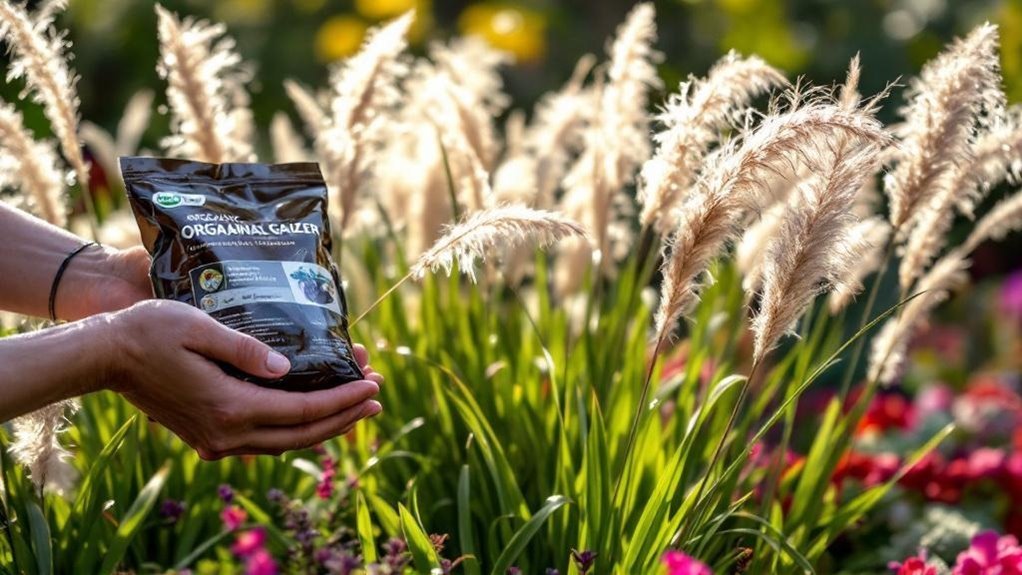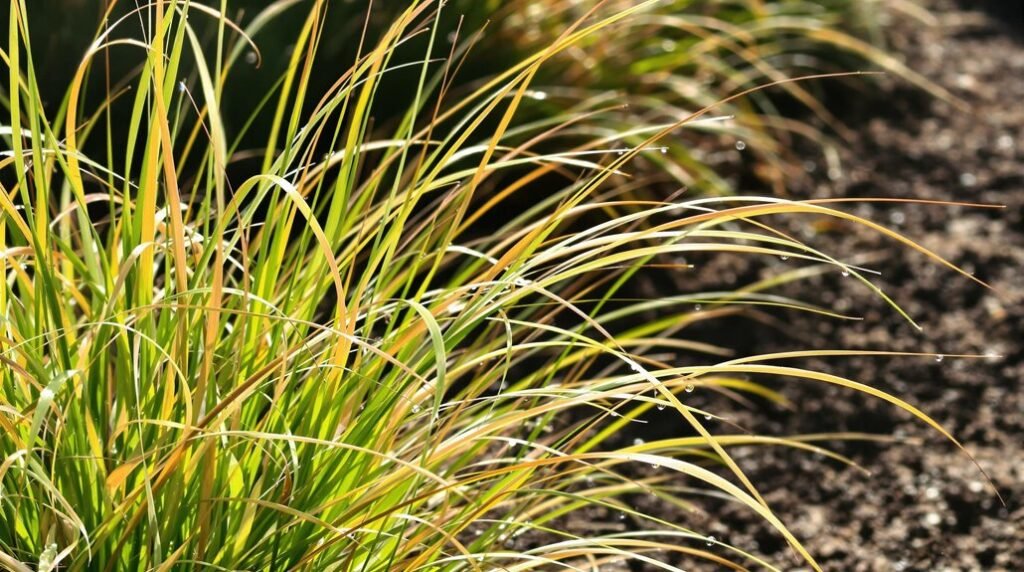Ornamental grasses might seem low-maintenance, but they actually require thoughtful care to truly flourish. You’ll want to choose the right varieties, plant them at the ideal time, and maintain proper watering and feeding schedules. Beyond that, cutting back and dividing can make a big difference in their health and appearance. Before you start, consider how pests, diseases, and seasonal changes might affect your grasses—understanding these factors will set you up for success.
Selecting the Right Ornamental Grass for Your Garden
How do you choose the perfect ornamental grass for your garden? Start by selecting the right ornamental grass that suits your garden’s design and privacy needs, considering height and growth habits.
Check your hardiness zone using the USDA Plant Hardiness Zone Map to guarantee the grass thrives in your region. Most grasses require well-drained soil, so assess your soil conditions to match this need.
Pay close attention to light requirements; some grasses flourish in full sun, while others tolerate partial shade. If you prefer cooler climates, cool-season grasses thrive between 60–75ºF, making them ideal for your garden’s temperature range.
Ideal Planting Times and Locations
When you plant ornamental grasses in spring or early fall, you give their roots 6 to 8 weeks to establish before harsh winter conditions arrive. These ideal planting times help guarantee strong root establishment and reduce stress from summer heat.
Choose a location with full sun for most grasses, though some varieties tolerate part shade depending on their light conditions. Prepare well-drained soil enriched with compost to boost nutrient availability.
Be mindful of mature size when planting; space grasses 1 to 3 feet apart to allow adequate growth and air circulation. Planting before summer heat supports healthy development, so avoid late planting.
Watering and Fertilizing Requirements

Although ornamental grasses become drought-tolerant once established, you’ll need to water young plants frequently—every other day at first, then twice a week during their first growing season. This frequent watering helps them establish strong roots.
Once established, many ornamental grasses require less water, but it’s important to monitor soil moisture to prevent dryness, which can cause brown leaf tips.
Applying a 2- to 3-inch layer of mulch in spring retains soil moisture and suppresses weeds, benefiting overall health.
Most ornamental grasses have modest fertilizer needs; using a slow-release fertilizer in spring supports growth without encouraging weak stems.
Techniques for Cutting Back and Dividing
Maintain the health and appearance of your ornamental grasses by cutting them back and dividing them at the right times.
Cut back ornamental cool season grasses in early spring, leaving about one-third of old growth, while warm season grasses should be trimmed in fall or mid-spring to a few inches tall.
Always wear thick leather gloves to protect your hands, and use pruning shears for smaller grasses. For larger clumps, consider stronger tools.
Tie grasses in bundles with rope or Velcro before cutting back to ease cleanup.
Divide ornamental grasses every three to five years when center growth thins.
Perform dividing in early spring for cool season and mid-spring for warm season grasses.
Verify each division has healthy roots for successful replanting to keep your grasses thriving year after year.
Managing Pests and Preventing Diseases

Catching pests like aphids and spider mites early can save your ornamental grasses from serious damage. Regularly inspect your plants to spot infestations and treat promptly with insecticidal soaps or neem oil.
To maintain a healthy growing environment:
- Promote good air circulation to prevent fungal diseases like leaf spot and powdery mildew.
- Avoid overhead watering to keep foliage dry and reduce disease risk.
- Remove dead foliage and debris promptly to eliminate pest hiding spots.
- Choose ornamental grasses with natural pest resistance to minimize problems.
- Use fungicides only if fungal diseases persist despite preventative measures.
Seasonal Maintenance and Winter Protection
As winter approaches, you’ll want to prepare your ornamental grasses to withstand colder temperatures while keeping their aesthetic appeal.
Avoid cutting back your grasses before winter; the remaining foliage provides valuable winter interest and protects the crowns from harsh weather.
In late fall, apply mulch around the base to retain moisture, suppress weeds, and improve plant health.
When spring arrives, cut back clumping grasses to 4-6 inches to encourage new growth.
Every 2-3 years, remember to divide your clumping grasses, guaranteeing each section has healthy roots for successful replanting.
Throughout winter, monitor for pests and diseases to catch any issues early.
Proper seasonal maintenance guarantees your grasses stay vibrant and strong year after year.
Frequently Asked Questions
Should Ornamental Grasses Be Cut Back?
You should cut back ornamental grasses to remove dead foliage and encourage healthy new growth. Use sharp, clean tools and trim at the right time—late winter for cool-season, fall or spring for warm-season grasses.
How Do You Maintain Ornamental Grasses?
You can’t just ignore ornamental grasses! Cut them back in late winter, water frequently at first, mulch generously, and watch for pests. Feed sparingly, too. These steps keep your grasses thriving and looking fabulous all year!
How Often Should I Water Newly Planted Ornamental Grass?
You should water newly planted ornamental grass every other day for the first two weeks to help roots establish. Keep the soil moist but not soggy, then gradually reduce watering as the grass grows stronger.
What Is the Lifespan of an Ornamental Grass?
Think of ornamental grass as a living poem, lasting 3 to 10 years. You’ll nurture it best by watering, dividing, and caring for soil, extending its vibrant life like seasons unfolding in your garden’s embrace.
Final Thoughts
Caring for your ornamental grasses is like nurturing a living work of art—they’ll reward you with beauty and movement all year long. By choosing the right varieties, planting at the best times, and keeping up with watering, feeding, and trimming, you’ll help your grasses thrive. Stay vigilant against pests and diseases, and don’t forget seasonal care to protect them through winter. With a little effort, your garden will dance gracefully with vibrant, healthy grasses.
